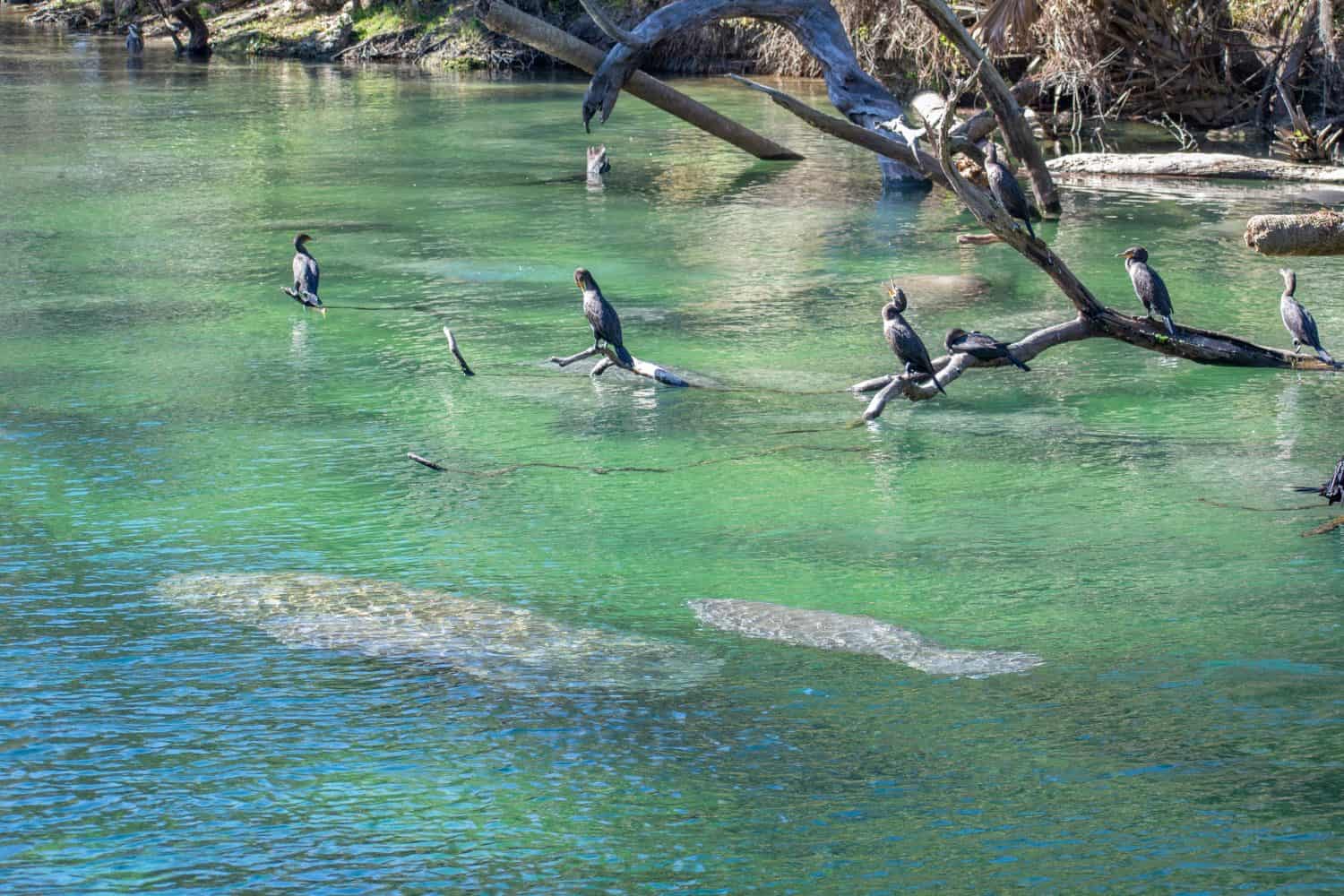Blue Springs State Park is an incredible state park in Florida. This unforgettable state park has a little something for everyone. Whether you want to spend all day playing in the water, kayaking, or spotting wildlife, you’ll find something to do. This state park though can get crowded and with so many activities, how do you plan the perfect day? Follow along to learn more about this state park, including the cost to enter, activities available, history, and more.
Where is Blue Springs State Park?
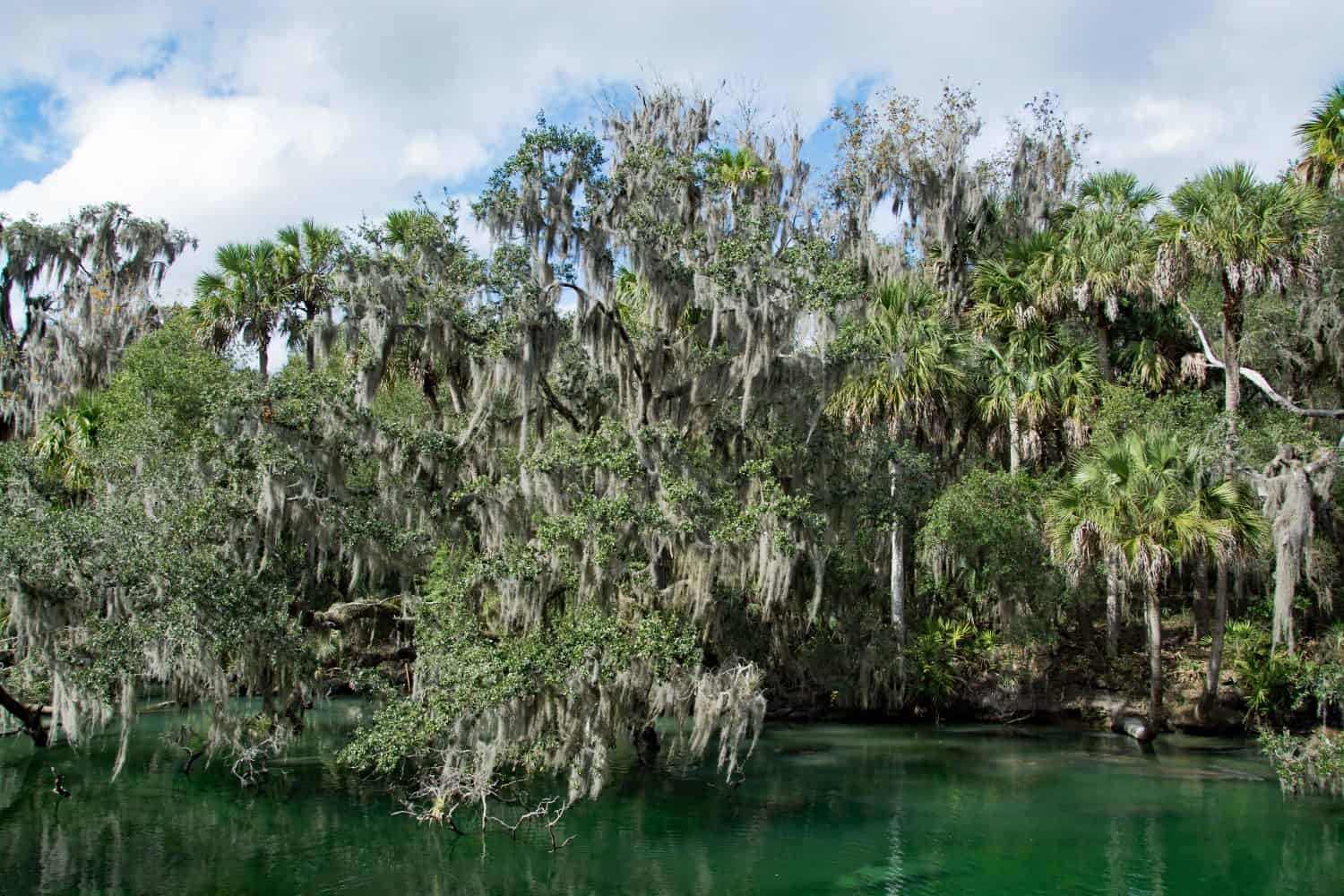
Blue Springs State Park is near Orange City, Florida in Volusia County.
©U. Gernhoefer/Shutterstock.com
Blue Springs State Park is near Orange City, Florida in Volusia County. Volusia County is between the St. Johns River and the Atlantic Ocean. It’s home to half a million people. Major cities in Volusia County include DeLand, Daytona Beach, Deltona, New Symrna, and Orange City.
Volusia County is gorgoues. There is much to do outside, not just at Blue Springs State Park. Other notable parks and beautiful outdoor areas are Hontoon Island State Park, Lake Woodruff National Wildlife Refuge, De Leon Springs State Park, and Canaveral National Seashore.
Orange City has a population of around 12,600. The surface area of Orange City is 7.92 square miles. It was incorporated as a city in 1882. This Florida city is home to many historic buildings, like the Louis P. Thursby House, Seth French House, and Orange City Town Hall.
About Blue Springs State Park
The history of Blue Springs stretches for hundreds of years. Long before European settlers found this area, it was home to the Timacuan people. The Timacuan people are called the first people or early people of Florida. Once European settlers landed in Florida, an estimated 200,000 Tumacuans lived in over 19,000 square miles of land. Two hundred later, there were only around 1,000 Timacuan left. Their numbers dwindled quickly because of war, slavery, and deadly European diseases like smallpox. Some Timacuan people though integrated with other indigenous groups.
More recent history of Blue Springs State Park starts with Louis Thursby, an orange grower. He purchased Blue Spring in 1856. In the 1900s, this stunning spring was a popular tourist attraction for its clear spring and fishing opportunities. To kick-start the manatee protection program, the spring and surrounding area were acquired by the Florida Department of Environmental Protection in 1972.
Best Time to Visit
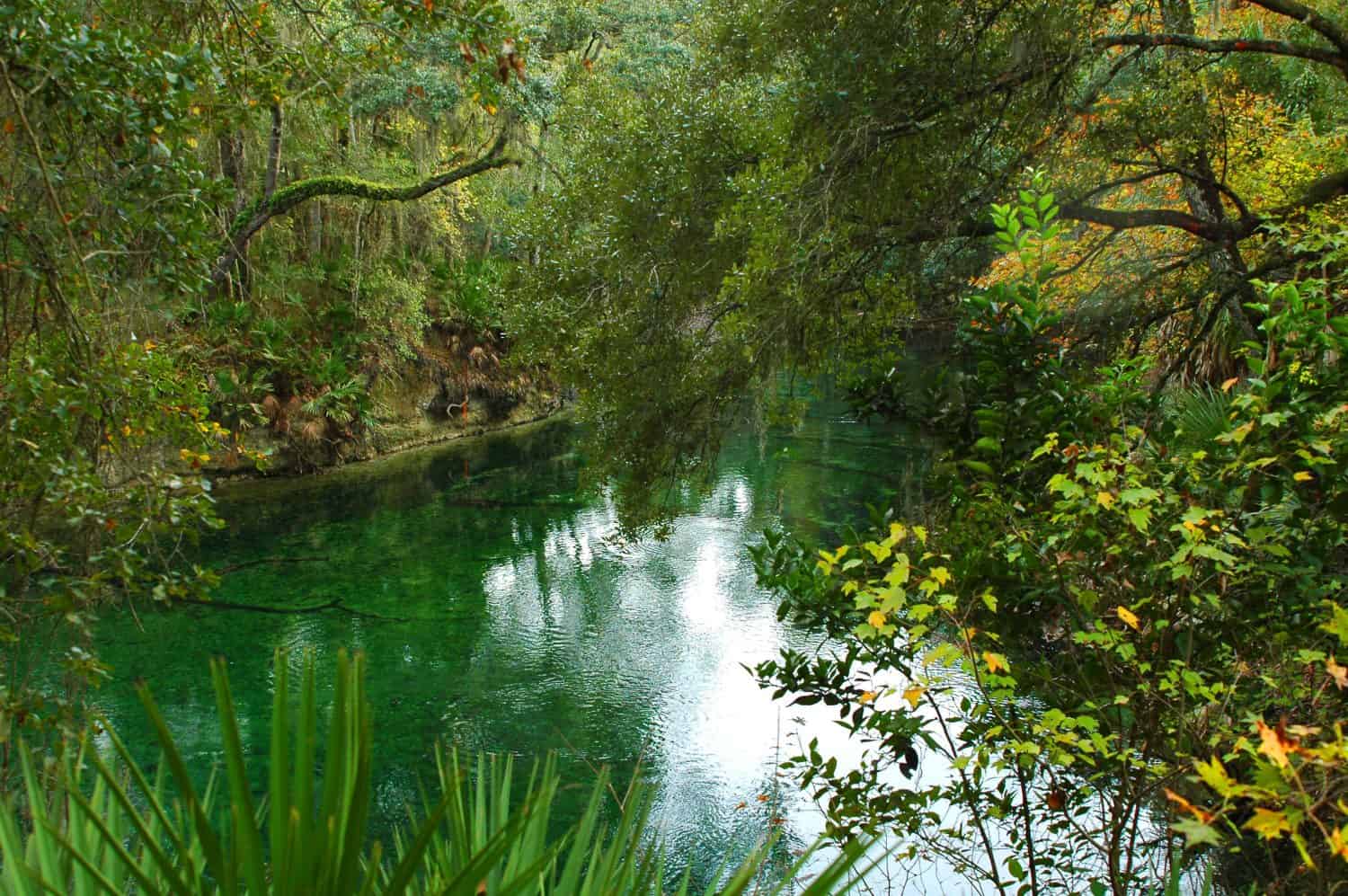
Blue Springs State Park offers opportunities to hike, camp, kayak, and swim.
©Caleb Foster/Shutterstock.com
Now that we know a little more about Blue Springs State Park in Florida, let’s discuss the best time to visit. The best time to visit depends on your interests. For instance, Blue Springs State Park is famous for its swimming opportunities. The water is cold, clear, and refreshing. The water is always generally 72°F. If you’d like to cool down, the summer is a great time to visit. However, summers are notoriously known for being the spring’s peak season. If you leave too late in the day, you may get turned away at the entrance as the spring frequently reaches capacity. For summer visitors, your best chance of visiting is to reach the state park 1 to 2 hours early on a weekday.
To beat the rush of people, you can visit Blue Springs during spring and fall. It’s still warm outside, but the water can feel chilly! Winter activities in the park though are also popular. If you want to spend your time hiking, biking, or camping, you can visit from October to April. Manatees are common in the park from November to April.
How To Get There
So, where is Blue Springs State Park, and how do you get there? This stunning state park isn’t too far from Orlando, Sanford, or Apopka. You can take local roads or the highway to reach the state park. It’s best to drive, but you can get dropped off in a ride-share app. Sometimes though, the signal in the state park can be rough, which may make it hard to book a ride home.
The closest airports to Blue Springs State Park are the Orlando International Airport, Daytona Beach International Airport, and Orlando Sanford International Airport.
Contact Information
Address: 2100 W. French Ave., Orange City FL 32763
Phone: 386-775-3663
Hours: 8 a.m. until sundown
Cost
Blue Springs State Park is a great place to visit if you’re on a budget. You can bring your picnic and only pay a small fee to enter. To enter the state park, a vehicle with 2 to 8 people must pay $6. Entry for one person driving a vehicle though costs $4. For pedestrians, bicyclists, extra passengers, and passengers in a vehicle with a holder of the Annual Individual Entrance Pass, it’s $2.
Camping is additional. To camp here, visitors must pay $24 per night plus tax and a nonrefundable $6.70 reservation fee. Additionally, guests with RVs must pay a $7 nightly utility fee, which includes water and electricity. If tent camping isn’t your thing, Blue Springs State Park also offers cabins. Cabins are $95 per night plus tax plus other fees. To rent a cabin, you must rent for at least two nights.
Activities

The Blue Springs State Park has a surface area of 2,643 acres.
You won’t get bored on your visit to the Blue Springs. While here, you can hike, kayak, camp, and more. Did you know tours are also available? While here, you can book a two-hour narrated nature and ecological cruise on the St. Johns River.
Hiking is just as cool. One of the best hiking trails is the 3.6-mile Pine Island Trail where you can see Florida scrub jays and other birds. Kayaking, canoeing, and paddle boarding are popular activities to do. As fun as it is to kayak and canoe, the spring and spring run sometimes close during winter and early spring when there are many manatees in the water. As amazing as manatees are, swimming and diving with them is not allowed.
What else is there to do in this state park? Visitors can view the Thursby House, and learn more about it. The Thursby House is a museum and interpretive center.
Wildlife
Hundreds of animals live in this state park. Hiking and paddling are great ways to view wildlife in Blue Springs. Within this park, there are 142 species observed bird species. If you’re lucky enough, you may even spot manatees in the water! Remember though, swimming with manatees is not allowed. It’s also important you don’t feed the wildlife.
American Alligators

American alligators can weigh over 1,000 pounds.
©Danita Delimont/Shutterstock.com
A very common animal in this state park is the American alligator. Wherever there is a body of water in Florida, there may be an alligator or two lurking underneath the surface. In Florida, there are about 1.3 million alligators! These incredible animals are massive, sometimes reaching over 16 feet long and 1,000 pounds. Although alligators rarely venture into the springs as the water is too cold, they sometimes venture in, especially during hot summers.
West Indian Manatees
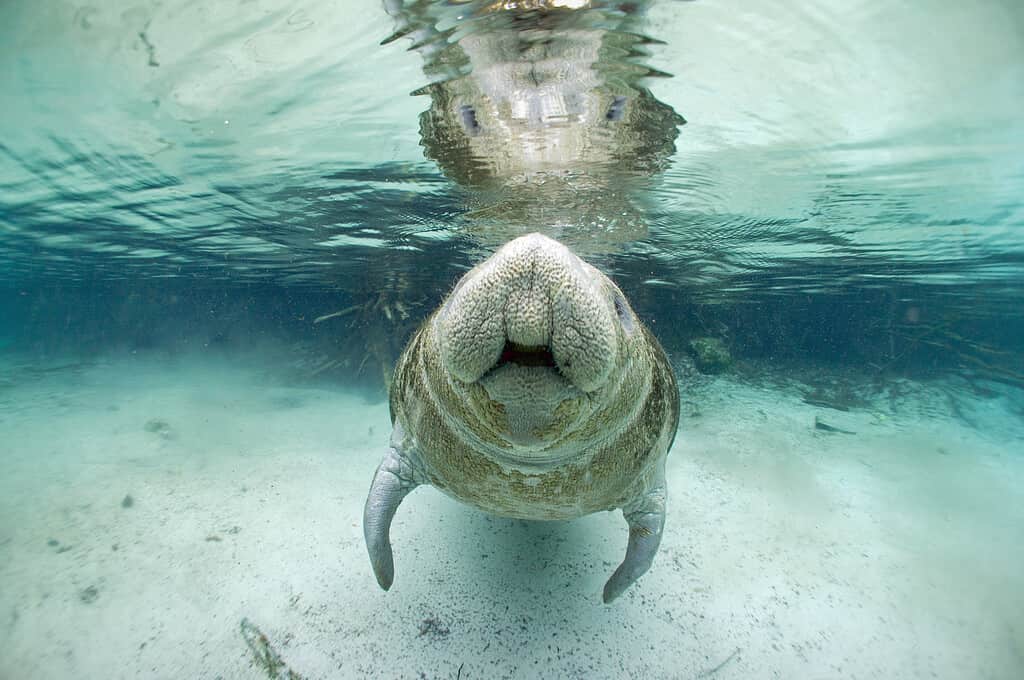
On average manatees swim 3 to 5 mph.
©tobiasfrei/ via Getty Images
An iconic Florida animal, like the American alligator, is the West Indian manatee. West Indian manatees are common in the state. These gentle giants swim to the springs during winter as the temperature in the springs is constant. These lovely animals are about 10 feet long and weigh between 800 to 1,200 pounds. Despite their large and sluggish appearance, manatees are agile and moderately fast, swimming up to 20 mph in short bursts. However, on average, a manatee swims 3 to 5 mph.
Whitetail Deer
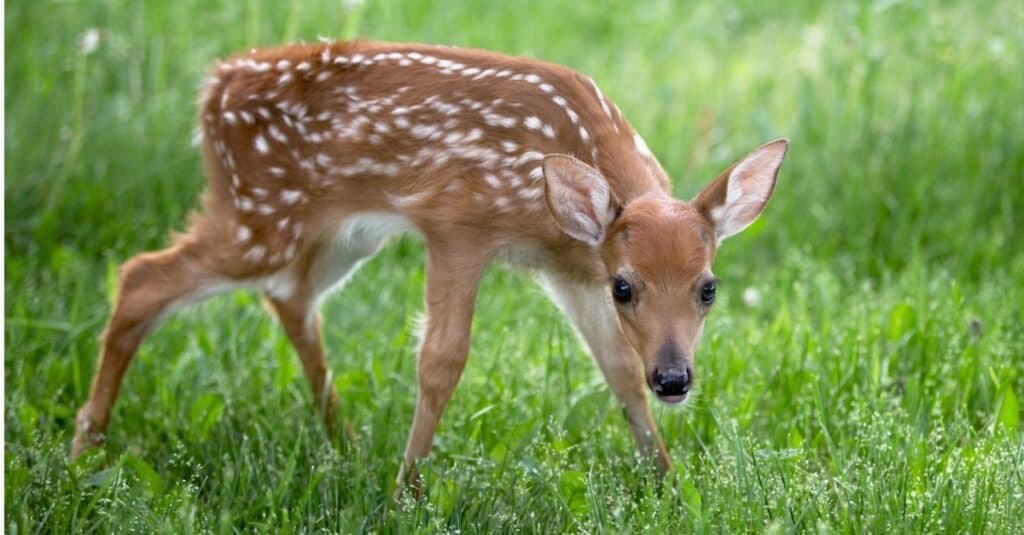
Whitetail deer can be found throughout Iowa.
©iStock.com/Lynn_Bystrom
On a hike through the state park, you may spot a whitetail deer. Like the previous two animals on this list, they are extremely common in Florida. Experts estimate there are about 700,000 whitetail deer in the state. Interestingly though, in 1985, there were only about 100,000 whitetail deer. To increase your chances of seeing a whitetail deer, get to the park early and hike quietly. Whitetail deer have excellent hearing and are easily frightened by noise.
Barred Owl

Female barred owls are slightly larger than males.
©Jim Cumming/Shutterstock.com
Another animal species in Blue Springs is the barred owl. These owls are common throughout the state. They live in mature trees of woodlands and swamps. Barred owls are about 1.5 to 2 feet long and may weigh up to 28 ounces. Female barred owls are slightly larger than males. Barred owls have a large diet. They consume fish, small mammals, insects, and other birds.
Thank you for reading! Have some feedback for us? Contact the AZ Animals editorial team.

